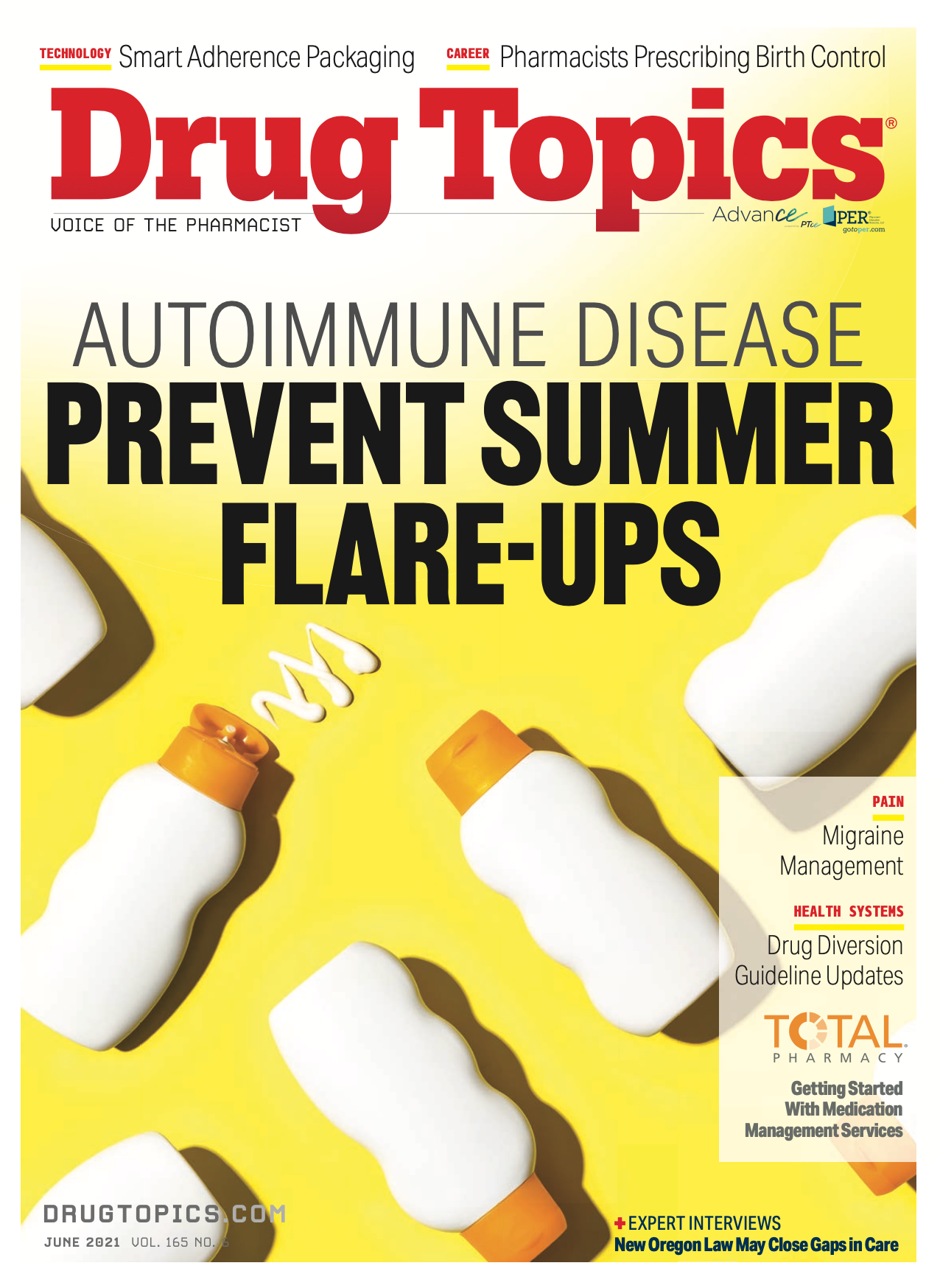Enhancing Medication Adherence With Smart Packaging
Smart tech improves medication management and workflow.

Demands on pharmacists are increasing, yet all the tasks historically part of a pharmacist’s day-to-day routine are still required. Aside from COVID-19 vaccinations and responding to overall increase in volume, medication adherence is a top concern for patients and pharmacists. Using technology solutions enables pharmacists to enhance patient safety both effectively and efficiently.
According to Gerald Finken, RPh, CEO of RxE2 Inc and a 40-year veteran pharmacist, technology-driven medication packaging is a tangible reminder for patients to take their medication as prescribed.
“Additionally, health plans, prescribers, and pharmacies are held accountable through adherence-driven quality metrics [such as proportion of days covered and medication possession ratio], and pharmacists can use packaging to improve these quality metrics,” Finken said.
Joann Seigel, RPh, vice president of pharmacy services for Masonic Villages in Elizabethtown, Pennsylvania, noted that with automated packing technology, pharmacists can confidently handle increased volume in the pharmacy without an increase in errors.
“It allows you to service a volume you could never manage manually,” she said. “Smart technologies streamline the med packing process.”
For the pharmacist, smart technology ensures that all a patient’s medications are synced up and billed at the same time, explained Donald Brindisi, RPh, pharmacy manager of Masonic Villages.
“It saves headaches around the concern that a patient is taking their medications as they are prescribed,” he said. “Without technology, supporting a patient that could have 10-plus medications in a single blister would be nearly impossible to do efficiently. We feel much more confident because of our automation.”
Thomas E. Hanzel, PharmD, MBA, national vice president of long-term care/nutraceutical at Parata Systems in Durham, North Carolina, said pharmacies are starting to be held accountable and, to some level, rewarded for improving adherence.
“The right technology can provide customizable adherence packaging that is flexible enough to be adopted by all customer types and, therefore, improve medication management,” he said. “Pharmacists can verify compliance, as the customer receives notice in a cyclical calendar format where the medications are automatically refilled. This can be on a weekly, monthly, or whatever cycle is best for the customer—therefore, decreasing the chance of missing a dose.”
Sapna Patel, RPh, director of clinical services at Mosaic Pharmacy Service in Sterling, Virginia, explained that previously, pharmacists had to spend a lot of time manually counting, filling, and labeling medications. With the automation of these tasks, pharmacists have additional time for patient interaction, including counseling patients on harmful drug-drug interactions, educating patients on disease states, and reiterating the importance of staying adherent to their medication.
“Pharmacy automation has also decreased medication errors made by pharmacists,” Patel said. “Many automation systems have a pill verification system that increases patient safety while decreasing human error.”
Therefore, adherence packaging services can increase a patient’s confidence in medication management and improve their overall health by helping them take their medications as prescribed.
Getting Started
If a pharmacy isn’t currently offering an adherence program, it usually is due to a lack of efficient technology. To start an adherence program, it can be helpful to have show-and-tells or introductory meetings with provider offices, discharge planners, short-term rehabilitation centers, and insurance companies, Seigel said.
“Getting key players involved early on to demonstrate the value of engaging with your adherence program is a great way to begin those partnerships,” she said. “Compliance packaging typically comes first and is then supported by the introduction of automation into the pharmacy.”
It will also depend on one’s customer base. For example, although smart cards are great for retail and behavioral health settings, they are not as ideal for long-term care settings.
“Knowing which patient populations you’re looking to support will dramatically change the type of adherence program and the way it is implemented,” Seigel said.
More and more seniors are staying in their own homes rather than going to a nursing home. A recent article in the Wall Street Journal reported a 15% drop in nursing home occupancy since 2019—mainly due to concerns around the COVID-19 pandemic.1 Seniors who live on their own may need additional support from their care providers when it comes to medication adherence.
“Adherence packaging has allowed pharmacists to help manage patients’ medications better by spending less time filling and more time managing their overall health,” Patel said.
For example, Patel cited a recent case study on a 70-year-old man on 25 medications. The patient has an extensive medical history, which includes diabetes, hypertension, overactive bladder, hyperlipidemia, gastroesophageal reflux disease, and neuropathy. He lives alone and has a hard time remembering to take some of his medications. He became nonadherent due to cost and medication overload.
“Mosaic Pharmacy Service leverages a comprehensive care model that includes filling medications in adherence packaging to help our medically complex patients stay adherent to multiple medications,” she explained. “I switched this patient to more cost-effective medications organized by date and time of dose in adherence packaging, which helped to simplify his routine and ultimately made it easier to stay adherent.”
COVID-19 has disrupted daily processes and routines for many patients, leading to medication adherence concerns. Pharmacists have had to implement strategies to help their patients stay adherent amid a variety of logistical challenges; this includes services like curbside pickup, home delivery, and—of course—adherence packaging.
“[COVID-19] has allowed pharmacists to see the importance of adherence packaging to help manage patient’s medication regimens,” Patel said. “Having all their medication synchronized to fill once a month allows for better adherence and more time for pharmacists to focus on helping patients manage their chronic conditions.”
Who Benefits Most?
Adherence packaging is good for any patient managing multiple chronic conditions that require them to take medications multiple times per day. It is also good for patients who have a caregiver helping them manage their medication because adherence packaging makes it easy to see if the medications have been taken at the scheduled time.
The patients most likely to benefit from adherence packaging are those whose caregivers may be far too busy to manage family members’ medications.
“Home health agencies really value compliance packaging for their facilities,” Seigel said. “Patients who may be very far away from their loved ones or a power of attorney can rest easier knowing their medications are being managed safely—which provides peace of mind for both the patient and those responsible for their care.”
The senior population is also at high risk of nonadherence, which is why Patel believes seniors who are on 5 or more medications would benefit most from adherence packaging.
“A recent report put out by the Lown Institute indicates that seniors on 5 or more medications are 88% more likely to seek care for an adverse drug reaction versus those taking 1 or 2 medications,” she said. “More and more seniors are wanting to age in [their own] place. Adherence packaging allows them to stay independent and adherent to their medication regimens.”
There are plenty of benefits for the pharmacists as well. Automation allows them to better manage workflow, produce more cards, and service a much larger customer base.
“It significantly reduces stress for the pharmacists, which inherently reduces burnout,” Brindisi said. “Because every step along the way is barcoded, there’s confidence that processes are reliable and that patients are in good hands.”
Plus, it allows pharmacists to work with patients to reduce their overall medical spend and ensure the best-possible treatment plan.
“The shift away from simply dispensing medications toward holistic patient care allows for better clinical outcomes,” Patel said.
Adherence pouch packaging also increases prescription fills and results in less audits, less direct and indirect remuneration fees, and higher reimbursement.
“Adherence technology decreases chances of medication errors and increases efficiencies, providing a high level of confidence to the pharmacist,” Hanzel said. “Automation also frees up pharmacist time and allows them to use their unique breadth and depth as experts who can then focus primarily on the patient. As a pharmacist, any way that they can improve adherence will [improve outcomes and, ultimately, reduce] total health care cost.”
Reference
- Mathews AW, McGinty T. Covid spurs families to shun nursing homes, a shift that appears long lasting. The Wall Street Journal. Updated December 21, 2020. Accessed May 3, 2021. https://www.wsj.com/articles/covid-spurs-families-to-shun-nursing-homes-a-shift-that-appears-long-lasting-11608565170
